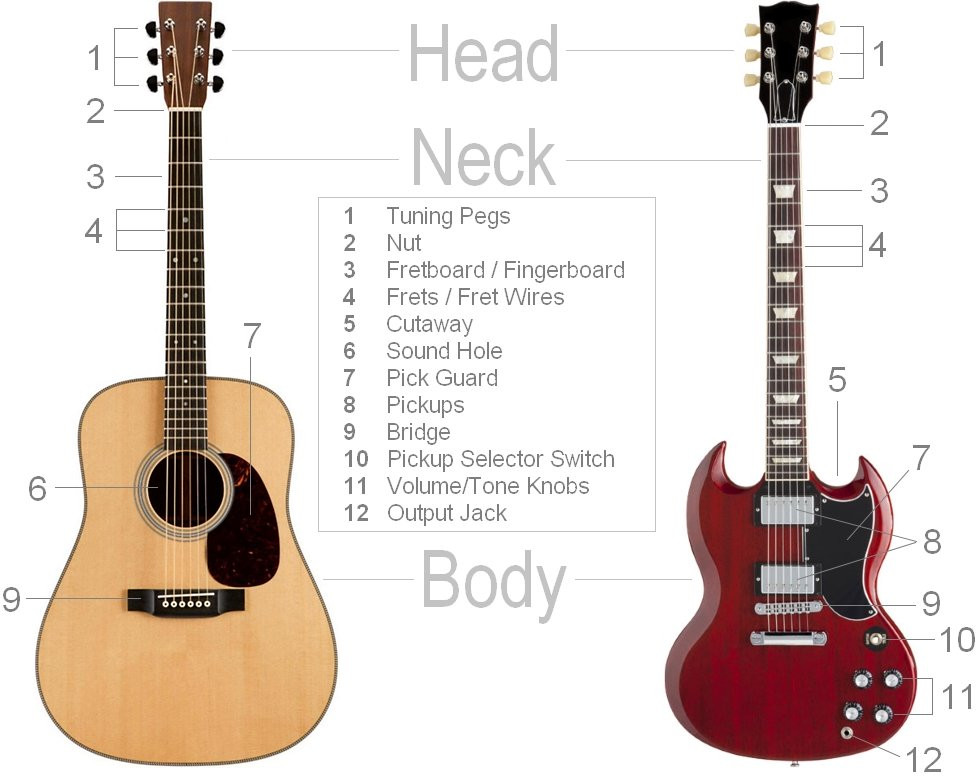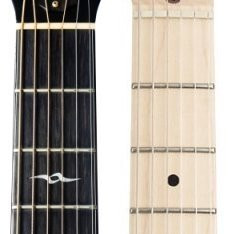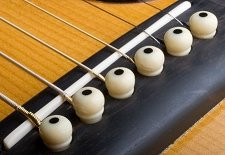Getting to know your guitar is a crucial first step for any aspiring guitarist. Just like learning the anatomy of any instrument, understanding the different parts of a guitar and their functions will significantly enhance your learning journey. This guide, complete with a helpful Diagram Of Guitar Parts, will walk you through everything you need to know.
Whether you’re just starting lessons or browsing for a new instrument, familiarity with guitar terminology is essential. This article breaks down the diagram of guitar parts, explaining each component clearly and concisely, making it easy for beginners to grasp. Let’s dive into the anatomy of the guitar!
Guitar Parts Diagram – Key Components Explained
As illustrated in the diagram below, the guitar, much like the human body, is broadly divided into three main sections: the head, the neck, and the body. Understanding these core areas is the foundation to learning about individual guitar parts.
 guitar parts diagram showing both acoustic and electric guitar
guitar parts diagram showing both acoustic and electric guitar
- Headstock: Often simply called the “head,” this is located at the top of the guitar and is where the tuning happens.
- Neck: The long piece of wood extending from the headstock to the body. This is where you position your fretting hand to play notes and chords.
- Body: The largest part of the guitar, resonating sound and providing a surface for strumming or picking.
Notice in the diagram of guitar parts that electric guitars, like the one on the right, often feature cutaways. These are curved indentations where the neck joins the body, designed to provide easier access to the higher frets for playing notes further up the neck. Cutaways can be found on both electric and acoustic guitars, particularly electro-acoustic models.
Exploring Individual Guitar Parts – A Detailed Breakdown
Let’s delve deeper beyond the main sections of the guitar parts diagram and examine each component in detail, from the headstock to the lower end of the body.
Headstock: The Tuning Hub
The headstock is critical for tuning your guitar and securing the strings. It houses the tuning machines, which are essential for adjusting string pitch.
On a standard six-string guitar, you’ll find six tuning machines, each controlling the tension of a string. Fine-tuning is achieved by turning the tuning pegs (also known as tuning keys or machine heads).
Headstocks come in three primary configurations, as shown in the images below:
3 Tuners Per Side Headstock: A symmetrical design with three tuning machines on each side.
In-line Tuners Headstock: All six tuners are arranged in a line, typically on one side of the headstock, common on guitars like Stratocasters and Telecasters.
Alt text: In-line tuner headstock diagram, showcasing six tuning machines in a row on an electric guitar, highlighting the modern design for efficient tuning.
Classical Tuners Headstock: Typically found on classical guitars, featuring two sets of tuning machines arranged perpendicularly to the headstock, often with nylon strings attached.
Each tuning machine consists of the tuning peg and the internal mechanism that rotates the tuning post. The string is threaded through a hole in the tuning post and wound around it. Turning the peg tightens or loosens the string, raising or lowering the pitch.
The headstock might also provide access to the truss rod, a metal rod running through the neck that adjusts its curvature (or “bow”). Truss rod adjustments are usually infrequent and are more relevant for advanced guitar setup, particularly when dealing with changes in temperature or humidity that can affect the neck. Adjusting the truss rod can help minimize fret buzz by ensuring the neck is properly aligned.
For further information on guitar setup, resources like this guide on WikiHow can be helpful. However, as a beginner, understanding the diagram of guitar parts is a more immediate priority.
Nut: String Spacing and Height
 guitar nut
guitar nut
The nut is a small but crucial component located at the end of the headstock, where the strings transition to the neck and fretboard. It has grooves or slots that space the strings correctly and set their height as they pass over the fretboard.
Nuts are made from various materials, including bone, plastic, graphite, Corian, and brass, each affecting tone and wear differently.
The nut defines one end of the string’s vibrating length when you play a note, the other end being the bridge.
Neck: The Foundation of the Fretboard
The neck is typically constructed from woods like mahogany or maple. It’s important to distinguish the neck from the fretboard, which is actually glued onto the neck itself. When you hold the guitar, your thumb rests on the back of the neck, providing support for your fretting hand.
Fretboard / Fingerboard: Where the Magic Happens
 rosewood and maple guitar fretboard
rosewood and maple guitar fretboard
The fretboard, also known as the fingerboard, is the surface on the neck where you press down the strings to produce different notes and chords. It features raised metal strips called frets or fret wires that are positioned at precise intervals. By pressing a string just behind a fret, you shorten the vibrating length of the string to create a specific pitch.
Rosewood and maple are the most common fretboard materials. Maple, being a lighter wood, generally contributes to a brighter and snappier tone, while rosewood offers a warmer, mellower sound.
Inlay markers are often found along the fretboard, usually dots or decorative shapes, located at specific fret positions (typically 3, 5, 7, 9, 12, 15, 17, 19, 21, and 24 frets, depending on the guitar). These markers help you visually navigate the fretboard.
Neck Joint: Connecting Neck to Body
The neck joint is the point where the neck is attached to the guitar body. Necks are typically joined using one of three methods: bolt-on (screwed to the body), set-in (glued into the body), or neck-through (neck wood extends through the body). Set-in and neck-through constructions are often associated with increased sustain, although bolt-on necks are still used in many high-quality guitars and offer a bright, articulate tone.
Pick Guard: Protecting the Finish
The pickguard, sometimes referred to as a scratch plate, is a piece of material attached to the body, primarily to protect the finish from scratches caused by strumming or picking. Pickguards also serve an aesthetic purpose, often contrasting in color or featuring designs to enhance the guitar’s appearance.
Pickups (Electric Guitars): Capturing String Vibrations
 electric guitar single coil and humbucker pickups
electric guitar single coil and humbucker pickups
Pickups are magnetic transducers located on the body, near the end of the fretboard. They detect the vibrations of the guitar strings and convert them into an electrical signal that is sent to an amplifier to produce sound.
The pickup closer to the bridge is known as the bridge pickup or lead pickup, typically producing a brighter, more cutting tone. The pickup nearer to the neck is called the neck pickup, rhythm pickup, or jazz pickup, and usually delivers a warmer, rounder sound.
The two main types of pickups are single-coil and humbucker (or double-coil). Single-coil pickups (common on Stratocaster-style guitars) are known for their clear, bright, and sometimes thinner sound. Humbuckers (often found on Les Paul-style guitars) offer a thicker, warmer, and more powerful tone. Humbuckers are often covered with metal casings for protection and shielding.
The term “humbucker” comes from their design to “buck the hum,” meaning they are designed to reduce unwanted noise and hum compared to single-coil pickups.
Tone & Volume Controls (Electric Guitars): Shaping Your Sound
These knobs and switches on electric guitars control the volume and tone of the signal coming from the pickups. Typically, guitars have a master volume control and one or more tone controls that affect the treble frequencies. Some guitars may have individual volume controls for each pickup.
Electric guitars also feature a pickup selector switch to choose which pickup(s) are active.
Guitars with three pickups, like Stratocasters, often have 5-way selector switches. These switches allow for combinations such as: bridge pickup only, bridge and middle pickups together, middle pickup only, middle and neck pickups together, and neck pickup only, offering a wide range of tonal options.
Sound Hole (Acoustic Guitars): Projecting Acoustic Tone
Alt text: Diagram of an acoustic guitar sound hole, showing rosette decoration and its function in projecting sound, emphasizing the acoustic properties of the guitar body.
Acoustic guitars use a sound hole in the body to project and amplify the sound of the vibrating strings. The sound hole allows the guitar’s body to resonate and project the acoustic sound outwards. Electro-acoustic guitars combine a sound hole for acoustic resonance with pickups and preamps, allowing them to be amplified through an external amplifier like an electric guitar.
Electric Guitar Bridge: Anchoring and Adjusting Strings
The bridge serves as the anchor point for the strings on the body and, along with the nut, determines the vibrating length of the strings. On electric guitars, bridges often have individual saddles for each string. Strings are threaded through the body or a tailpiece and then rest on these saddles.
Electric guitar bridges are often adjustable for string height (action) and intonation, which is the accuracy of pitch across the fretboard.
Some bridges are designed to accommodate a tremolo arm (also known as a whammy bar). The tremolo arm allows you to manipulate the bridge to change the string pitch temporarily, creating vibrato and other pitch-bending effects like “dive bombs.”
A tune-o-matic bridge is an example of a fixed bridge (non-tremolo) commonly found on guitars like Les Pauls, known for its stability and sustain.
Acoustic Guitar Bridge: Simplicity and Resonance
 acoustic guitar bridge
acoustic guitar bridge
The bridge on acoustic guitars shares the same fundamental purpose as on electric guitars—transferring string vibrations to the guitar body. However, acoustic bridges are typically simpler in design. They usually consist of a single piece of wood (like rosewood) with a raised saddle (often made of bone or synthetic material). Strings pass over the saddle and are secured with bridge pins or fixed directly within the bridge.
Strap Buttons: For Guitar Straps
Strap buttons are simple but essential hardware that allows you to attach a guitar strap. Typically, there is one strap button at the base of the body and another at the upper part of the body near the neck joint, or sometimes even on the neck heel itself.
Strings: The Source of Sound
Strings are, of course, what produce the sound on a guitar. They come in various gauges (thicknesses) and materials. Electric guitars use steel strings, while acoustic guitars can use steel, brass, or bronze strings. Classical acoustic guitars use nylon strings.
String gauge is measured in inches. For example, a common high E string gauge is .010 inches. Guitarists often refer to string sets by the gauge of the thinnest string, such as “10s,” meaning a set where the high E string is .010 inches thick.
Common string gauges for electric guitars range from .009 (extra light) to .013 (medium). Heavier gauge strings require more finger strength to fret but often produce a fuller, more robust tone.
For reliable and quality strings, D’Addario strings are highly recommended. Their EXL series for electric guitars and Phosphor Bronze for acoustic guitars are known for their durability, consistent tone, and corrosion-resistant packaging.
By understanding this diagram of guitar parts and their functions, you’re now better equipped to learn, play, and maintain your guitar. Happy playing!
